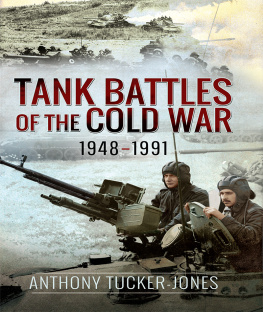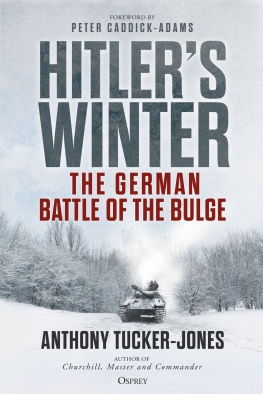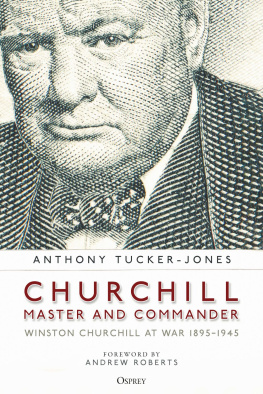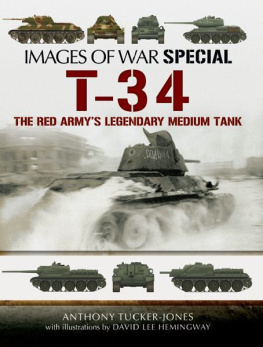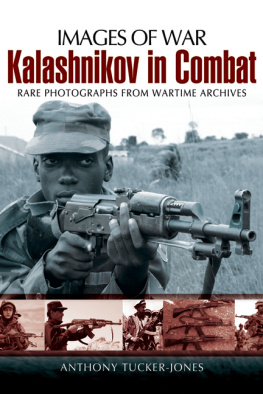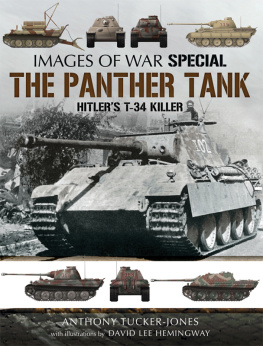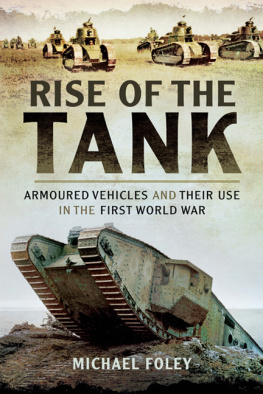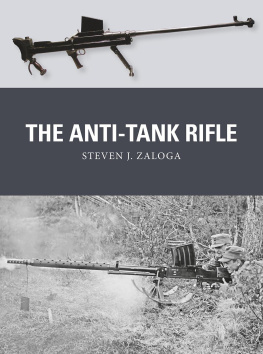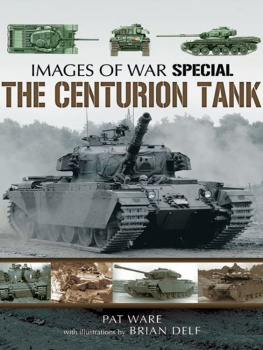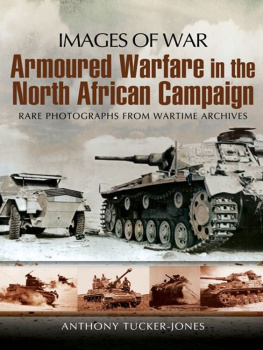Pagebreaks of the print version

Tank Battles of the Cold War 19481991
Tank Battles of the Cold War 19481991
Anthony Tucker-Jones
AN IMPRINT OF PEN & SWORD BOOKS LTD
YORKSHIRE PHILADELPHIA
First published in Great Britain in 2021 by
PEN & SWORD MILITARY
An imprint of Pen & Sword Books Ltd
Yorkshire Philadelphia
Copyright Anthony Tucker-Jones, 2021
ISBN 978-1-52677-801-7
eISBN 978-1-52677-802-4
Mobi ISBN 978-1-52677-803-1
The right of Anthony Tucker-Jones to be identified as the author of this work has been asserted by him in accordance with the Copyright, Designs and Patents Act 1988.
A CIP catalogue record for this book is available from the British Library.
All rights reserved. No part of this book may be reproduced or transmitted in any form or by any means, electronic or mechanical including photocopying, recording or by any information storage and retrieval system, without permission from the Publisher in writing.
Pen & Sword Books Ltd incorporates the Imprints of Aviation, Atlas, Family History, Fiction, Maritime, Military, Discovery, Politics, History, Archaeology, Select, Wharncliffe Local History, Wharncliffe True Crime, Military Classics, Wharncliffe Transport, Leo Cooper, The Praetorian Press, Remember When, White Owl, Seaforth Publishing and Frontline Publishing.
For a complete list of Pen & Sword titles please contact
PEN & SWORD BOOKS LTD
47 Church Street, Barnsley, South Yorkshire, S70 2AS, England
E-mail:
Website: www.pen-and-sword.co.uk
or
PEN & SWORD BOOKS
1950 Lawrence Rd, Havertown, PA 19083, USA
E-mail:
Website: www.penandswordbooks.com
List of Plates
Plate Section I (between pages 52 and 53)
Second World War M4 Sherman tank.
North Korean Soviet-supplied T-34/85s.
An American M4 Sherman serving in Korea.
An M26 Pershing tank engaging a North Korean target.
An American M46 Patton deployed as a self-propelled gun in Korea.
M24 Chaffee light tank in the Korean War.
A French Expeditionary Forces Chaffee in Indo-China.
M113 armoured personnel carriers in the jungle.
A mixed convoy of M48 Patton tanks and M113 armoured personnel carriers in Vietnam.
A Pakistani Sherman destroyed during the 1965 Indo-Pakistan War.
Israeli M51 Shermans in the Negev desert in southern Israel prior to the Six Day War.
Egyptian T-34/85s on the move in the El Arish area in late May 1967.
This wrecked Egyptian T-34/85 was destroyed during the fighting at Rafah in the Gaza Strip during the Six Day War in June 1967.
The buckled remains of an M48.
The fate of all the Arab armies in 1967: total destruction.
The RG-7 the standard Soviet infantry anti-tank weapon throughout the Cold War.
The bulky AT-3 Sagger anti-tank.
The man-portable version of the Sagger.
Plate Section II (between pages 116 and 117)
US Marines advance, supported by an M48 Patton during street fighting in Hue, Vietnam, 1968.
American troops examining a knocked-out North Vietnamese Army PT-76 amphibious light tank.
An Israeli M48 Magach taking on ammunition somewhere in Sinai in 1973.
A column of Israeli M48 Magachs moving towards the Suez Canal during the Yom Kippur War.
Israeli Centurions supported by armoured infantry firing on Syrian tanks on the Golan Heights, 1973.
Syrian T-54s knocked out on the Golan Heights.
More Syrian T-54/55 tanks destroyed whilst fighting the Israelis.
The business end of an Israeli Centurion.
South Vietnamese soldiers with a damaged North Vietnamese Type 59 captured in 1972 south of Dong Ha during the Norths Easter Offensive.
The Ethiopian Army captured this Somali T-54 tank during the Ogaden War.
This T-54/55 came a-cropper in Ethiopia during the long and brutal civil war.
Mujahideen with a burnt-out T-34/85.
A Mujahideen tank hunter.
A resistance anti-tank team ambush a Soviet armoured vehicle with their RPG-7.
The British Chieftain tank.
Dug-in Iraqi T-55s.
Israeli Zelda M113 armoured personnel carriers in Lebanon.
An Angolan T-54.
Plate Section III (between pages 180 and 181)
A British Challenger with the Royal Scots Dragoon Guards in Iraq in 1991.
Frances AMX-30 armed with a 120mm gun, used by the French, Saudis and Qataris during operations in 1991.
An M1A1 Abrams of the 3rd Brigade, US 1st Armored Division, races across the desert in northern Kuwait during Operation Desert Sabre.
An American column, protected by Abrams tanks and Bradley infantry fighting vehicles, prepares for the offensive.
More armour from the US 1st Armored Division.
A Kuwaiti M-84 during Operation Desert Sabre.
Soldiers examine an Iraqi T-54 tank destroyed by the French 6th Light Armoured Division.
Lacking air support, much of Saddams armour met this end.
This Iraqi tank was caught in the open.
The crew of this Iraqi T-72 did a good job of camouflaging their vehicle, but it did not save them.
A destroyed Iraqi T-55 tank at Jalibah airfield.
The burnt remains of Iraqi BMP-1s.
This Iraqi T-72 was destroyed in a Coalition attack near the Ali Al Salem air base.
An Iraqi T-55 tank near the Basra-Kuwait Highway, the scene of one of the final Coalition attacks.
The debris of defeat: two Iraqi T-55 tanks abandoned on the Basra- Kuwait Highway near Kuwait City.
Abandoned T-55 and T-62 tanks on the streets of Addis Abba in 1991, at the end of the Ethiopian civil war.
Four Yugoslav National Army T-55s ambushed by Slovenian forces on the Italian border at Rozna Dolina in the suburbs of Nova Gorica in western Slovenia in 1991.
Acknowledgements
My thanks to the marvellous team at Pen & Sword, Rupert Harding, Sarah Cook, Ron Wilkinson and Tara Moran. Also very belated thanks to Professors Ron Barston and Christopher Clapham who first awakened my interest in international conflicts and in particular the Cold War.
Introduction
The Cold War was not spared the brutality of armoured warfare. The fate of tank crews around the world hung in the balance, as it always had since the First World War. A British reporter who visited the Ethiopian battlefield of Afabet in 1988 wrote with amazement:
The Eritrean fighters were lazing around in the sun, laughing. A motley looking bunch in khaki shirts, denim jeans and rubber sandals, they had just overwhelmed Ethiopian armour, artillery and infantry and taken Afabet. It was one of the biggest battles in the history of the war with Ethiopia.
An entire Ethiopian mechanized brigade had been destroyed and many crew perished with their tanks. A British cameraman at Afabet also witnessed the scene:
Burnt-out tanks stretched as far as the eye could see; guns and bodies so badly burned they barely resembled corpses littered the roadside; the remains of Ethiopian truck drivers could be seen hanging out of windows, burnt to death as they attempted to flee. It was a place of horror and slaughter from which the world could be told about the war by television.
Before tank school, many of the Ethiopian crews had been simple farmers or herdsmen. At best they were familiar with a tractor or a truck. They had died in steel coffins far from their farmlands. Three entire Ethiopian infantry divisions also vanished from the face of the earth, such was the scale of the Eritrean victory.

